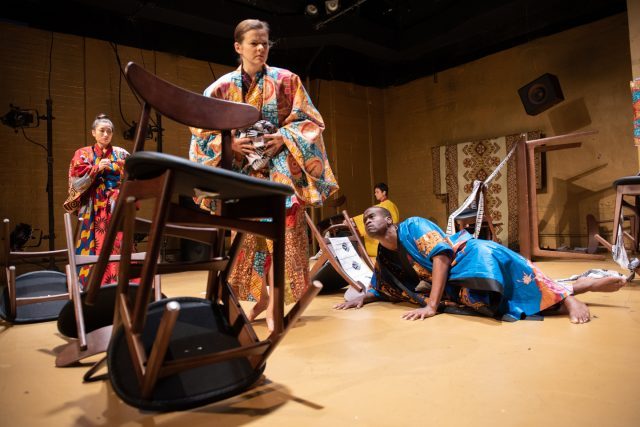
BrandoCapote takes place in a Kyoto hotel that doubles as purgatory (photo by Miguel Aviles)
The Tank
312 West 36th St. between Eighth & Ninth Aves.
Tuesday – Sunday through November 24, $25
thetanknyc.org
In 1957, thirty-two-year-old writer and journalist Truman Capote was sent to Kyoto by the New Yorker to do a story on thirty-three-year-old actor Marlon Brando, who was in Japan making Sayonara, Joshua Logan’s movie based on James Michener’s novel about an air force pilot who falls in love with a Japanese dancer during the Korean War. Husband-and-wife team Reid and Sara Farrington use the resulting article, “The Duke in His Domain: Marlon Brando, on Location,” as the jumping-off point for the multimedia production BrandoCapote, continuing at the Tank through November 24. The seventy-minute show, set in the hotel where Capote is interviewing Brando, also incorporates elements of Capote’s 1965 nonfiction novel, In Cold Blood, an investigation into the senseless murder of the Clutter family in Kansas by Dick Hickock and Perry Smith, as well as the tragic circumstances surrounding Brando’s son Christian, daughter Cheyenne, and Cheyenne’s boyfriend, Drag Drollet.
As they have done in such previous dazzling works as The Passion Project, CasablancaBox, Gin & “It,” and A Christmas Carol, the Farringtons use film clips to propel the narrative, projected with pinpoint precision onto Japanese fans and umbrellas that the five-person cast open up and turn toward the audience. For example, a clip of Brando as Col. Kurtz in Apocalypse Now asking, “Are you an assassin?” is followed by Capote answering, “No no no, I’m a journalist!” The dialogue is a compelling, sometimes confusing patchwork, with some lines spoken live by the actors onstage — Rafael Jordan as Brando, Jennifer McClinton as Capote, Lynn R Guerra as Brando’s mother, Dodie, Laura K Nicoll as Cheyenne, and Cooper Howell as Christian — some from the film clips, and others prerecorded audio snippets (with Sara Farrington and Akiyo Komatsu delivering different vocal impressions of Capote), in which case it is sometimes lip-synced, causing a panoply of beguiling chaos. “He paused, seemed to listen, as though his statement had been tape-recorded and he were now playing it back,” Capote writes of Brando in the article.

Clips from Marlon Brando movies are projected onto such objects as umbrellas to propel the plot of multidisciplinary work at the Tank (photo by Miguel Aviles)
Dressed in colorful kimono designed by Andre Joyner and constructed by Kelvin Gordon-El, the actors move to intricate choreography by Nicoll based on Japanese noh, bunraku, and kabuki traditions that repeats continually throughout the show, as if the director is yelling “Cut!” and the scene is being done over. “Sorry, sorry. Lemme start over. I’m gonna get this right,” Brando says after re-creating a violent scene from A Streetcar Named Desire. There are also excerpts from On the Waterfront, Mutiny on the Bounty, Julius Caesar, Last Tango in Paris, The Missouri Breaks, Sayonara, The Godfather, and other Brando films, many of which deal with childhood and the relationship between parents and children. “The son becomes the father, and the father the son,” Brando as Kal-El says to his infant son in a clip from Superman. “You are all my children,” Brando as Dr. Moreau tells his hideous creations in The Island of Doctor Moreau. Meanwhile, Brando threatens to kill his father if he ever beats his mother, a wanna-be actress, again. And after being called a “sissy” by other kids, Capote says of the bullies, “Buttoned up, boring, faceless nobodies — the kind of son my mother always wanted.”

The set is continually destroyed and resurrrected in Reid and Sara Farrington’s BrandoCapote (photo by Miguel Aviles)
Chairs and tables are overturned, carried offstage, then brought back on as the characters fold up and then ritualistically unfurl long black-and-white or red obi sashes, placing them carefully across the floor. Someone calls out, “Let’s get back to the interview,” and a sound glitch takes the action back to Capote in the hotel, which doubles as purgatory. It all comes off like clockwork, which is fascinating to experience. It is also repetitive in an abstract way, which can be both titillating and aggravating. But it’s always stimulating, both aurally and visually. “I’m not an actor,” Brando says self-effacingly. “I’m a mimic. Everyone is. And I’m not successful.” However, BrandoCapote is, in part by not merely mimicking its two famous celebrities but taking their story to another level.